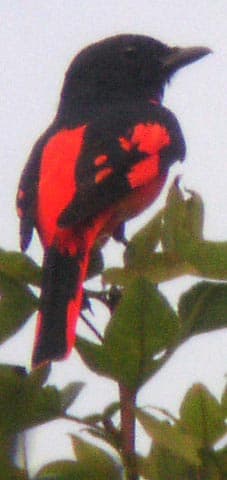You don’t need much equipment to start birdwatching. A pair of binoculars and a field guide will get you started on finding the wealth of species in Hong Kong.

Do you watch wildlife, such as birds, butterflies, dragonflies, mammals, fish or even crabs or beetles? If so, you will know some of the immense rewards of wildlife watching. But if not, perhaps give it a try – it’s a way of experiencing different “worlds”, while making new friends, exploring places few people go and boosting exercise; and a great way to unwind from city stress.
I’ve been interested in wildlife since childhood. During my teens, I became an extremely keen birdwatcher, and this has remained a lifelong passion of mine.
When I arrived in Hong Kong in the late 1980s, there were relatively few birdwatchers here, and most were westerners working in the city. But in the years since there has been a major and very welcome change, with far more local people taking up birdwatching – and bird photography.
You don’t need much equipment to start birdwatching. A pair of binoculars is important for improving views of birds, which can look very different seen “up close” like this, rather than just viewed with the naked eye. A field guide helps to identify them. And nowadays, the internet is a rich source of information, including the website of the Hong Kong Bird Watching Society.
Then, you will need somewhere to look for birds. The best place in Hong Kong is Mai Po Marshes Nature Reserve, but it’s not so easy to visit when you wish, so I advise trying somewhere that’s readily accessible.
Even a city park can be worthwhile. Kowloon Park, for instance, is a good place to see several of Hong Kong’s common birds. These include two species of bulbuls, which are songbirds that call loudly and perch prominently, often in small groups, and to me seem always cheeky and cheerful. Black-and-white Magpie Robins hop on the ground, alert for a tasty insect or worm. Bigger, bulkier Black-collared Starlings strut across lawns,.
Other conspicuous birds may include Blue Magpies, which have black heads, red beaks, blue upperparts and extravagantly long tails. Common Koel – a kind of cuckoo – is inconspicuous when silent. When singing, however, everyone surely knows there’s a Koel around, as the ko-el ko-el ko-el song rings out day and night. No wonder I’ve heard a local name for this species is “Noisy Bird”.
Another local name I’ve heard of is “Seven Sisters” – for Masked Laughingthrush, which travels through the undergrowth in bands of around seven birds, shrieking and yelling and chattering and squabbling. “Seven sisters”, haha; maybe named by the person who thought three women make a market!
Some birds might take more effort to see, like Common Tailorbirds that seek insects in shrubberies. Plus, while the birds I’ve mentioned are present year-round, you might also find migrants that spend winter in Hong Kong, or pass through during spring and autumn.
Beyond the city are many more places you can watch birds. Country parks hold a fair variety, but typical hiking routes pass through areas where you won’t find much diversity, as the variety of trees and other plants is often low. Instead, try the richer forests, such as in Shing Mun Country Park, and Tai Po Kau Special Area. These are home to some of our most colourful birds, like minivets with black and red plumage; but you will also find that forest birdwatching is frustrating. You might hear birds, while seeing little but trees. Yet keep going and you may find yourself suddenly surrounded by a flock of small birds, busily moving through the trees. And even with no birds in sight, the forests are wonderful wild places.
Farmland, including abandoned fields, attracts a mix of woodland edge and open country birds, some of which are easily seen as they perch on wires and posts. As this short column indicates, the bird species you can find at a place depend on the habitats, so a rural place with wet areas as well as dry fields, plus grassy areas and woodland, can be more rewarding to visit than somewhere with just fields.

One such place is Long Valley, near Sheung Shui. Thanks to the efforts of conservationists, it was saved from the MTRC’s plans to build a viaduct over the area, and attracts a wealth of birds, ranging from tiny munias that feed on grass seeds, to waterbirds such as herons and egrets. Birds that are rare in Hong Kong occur as well.
Visit Long Valley, and you will find it is also a Mecca for birdwatchers and bird photographers, whom you might also find interesting to watch. Some are experienced and knowledgeable; some are beginners. Sadly, there are also bird photographers who apparently care little for birds and nature, but only strive to manufacture photos that may bring them praise.
As you learn more about birds, you will discover more local birdwatching hotspots – notably Po Toi, which is akin to a magnet for migratory species. You might even make holiday plans focused on visiting some of the world’s great places for birds and other wildlife: way better for mind and soul than simply shopping or lying on a beach! And I hope you will become involved in efforts to protect our wild bird “friends”, which are invaluable yet under-appreciated in enhancing our quality of life.
Written for Ming Pao Weekly; appeared [in Chinese] in April 2013.

觀鳥樂趣多 你我同分享
你有觀賞雀鳥、蝴蝶、蜻蜓、哺乳動物、魚類,或是蟹或甲蟲等野生動物嗎?如果有,你一定知道箇中樂趣。沒有的話,不妨放膽試試:感受不一樣世界的同時,你還可認識新朋友、發掘人跡罕至的地方、增加運動量,絕對是都市人的減壓良策。
我自小已對野生動物產生興趣,十來歲時已成為熱愛觀鳥的人。觀鳥是我畢生鍾情的活動。
我在上世紀八十年代來到香港,當時觀鳥人數相對較少,大部份都是在此工作的洋人。幾十年來,越來越多本地人愛上觀鳥和雀鳥攝影,實在可喜。
觀鳥其實只需很少器材,最重要的是一副可擴闊視角的望遠鏡,讓你「近鏡」欣賞肉眼看不到的影像。要辨別雀鳥種類可帶備圖鑒,也可參考網上的豐富資訊,例如香港觀鳥會網站。
裝備妥當後,你便需要一個可找到鳥類的地方。米埔自然保護區是香港的最佳觀鳥地點。當然,申請需時並不能坐言起行,所以我建議選擇容易前往的地方。
九龍公園一類市區公園,便是十分值得一試的好地方。這裡可欣賞香港常見鳥類,其中有兩種歌聲嘹亮、在顯眼地方棲息的鵯,牠們喜歡小群出現,樣子逗趣開朗。黑白色的鵲鴝在地上跳彈,時刻留意搜捕美味昆蟲。在草坪上高視闊步的,還有體型較大的黑領椋鳥。
其他容易看到的雀鳥,還有黑頭紅嘴的藍鵲,牠們上身藍色,尾部華麗修長。常見的噪鵑是杜鵑的一種,不發聲時不容易察覺。但只要金口一開,便會日以繼夜地唱著喔哦喔哦,所有人都會知道牠們就在附近,難怪得名「噪」鶰。
黑臉噪鶥在香港又稱「七姊妹」,牠們在林下植物間飛翔,而且總是七七成群、吱吱地尖聲叫喊、喋喋不休、爭拗不絕。為「七姊妹」命名的人,大概十分明白什麼是三個女人一個墟!
長尾縫葉鶯一般都躲在灌木叢中搜尋昆蟲,需要多花心思才可以看到。除了上述四季可見的鳥兒,你還可能會遇上在港過冬的候鳥,或是在春、秋時路過的品種。
市區以外還有更多看鳥的地方。在郊野公園便可看到不少種類,但一般遠足路徑經過的範圍,由於樹木和植物種類通常相當有限,可吸引的鳥種不多。你可以試試到樹木種類較豐富的森林,例如城門郊野公園和大埔滘特別地區。兩地都是色彩最鮮艷鳥類聚居之地,住客包括長滿紅黑羽毛的山椒鳥。當然,你也會發現在林中賞鳥往往令人沮喪。明明聽到鳥聲,卻只見樹木,不見鳥影。請不要放棄,因為轉眼你又會看小鳥成群在林間繁忙飛動。就算視線內沒有鳥兒,森林本身也是美妙的野外地點。
農地(包括已荒廢農田),同樣吸引各類木林邊端和田野鳥類,有些站在電線與燈柱上休息時便很容易看到。就如本專欄指出,可見鳥種視乎地區所提供的棲所,前往有濕潤地區域和乾田、草地木林的郊外地點,會比在只有農田之處看到更多不同雀鳥,收穫更大。
鄰近上水的塱原便屬於這種地方。感謝各界保育力量,塱原終於避過港鐵在上面建造行車管道的計劃,繼續吸引著各式鳥類,包括吃草籽的小文鳥,還有鷺和白鷺等水禽。在香港罕見的鳥類也會在此出現。
作為觀鳥人和鳥類攝影者的聖地,塱原也是觀賞人群的熱點!他們有些擁有豐富的經驗和知識,也有些只是初學者。不幸的是,部份攝影人士似乎不大關心鳥類和自然,只顧製造為他們帶來讚譽的照片。
加深對鳥類認識後,你會發現本地更多觀鳥熱點。例如蒲台島這個堪稱各式候鳥磁石的小島。你甚至可以把賞鳥或觀察其他野外生物編成假日行程的重點節目,這要比在逛街購物,又或躺在沙灘上偷閒更有益身心。衷心希望你一同參與保護野生雀鳥的組織。雀鳥朋友為我們帶來不少益處,是改善生活質素的無名英雄。